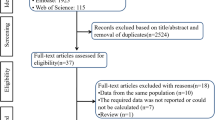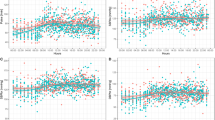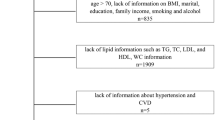Abstract
A body of evidence from basic science and clinical research is emerging to provide a compelling argument for endothelial dysfunction as a central etiologic factor in the development of atherosclerosis and vascular disease (ischemic heart disease, stroke, and claudication). Erectile dysfunction (ED) is another prevalent vascular disorder that is now thought to be caused by endothelial dysfunction. In fact, a burgeoning literature is now available that suggests that ED may be an early marker for atherosclerosis and cardiovascular disease (CVD). The emerging awareness of ED as a barometer for CVD represents a unique opportunity to enhance preventive vascular health in men. The diagnosis of ED could become a powerful clinical tool to improve early detection of atherosclerosis and initiate prompt aggressive medical management of associated cardiovascular risk factors.
This is a preview of subscription content, access via your institution
Access options
Subscribe to this journal
Receive 8 print issues and online access
$259.00 per year
only $32.38 per issue
Buy this article
- Purchase on Springer Link
- Instant access to full article PDF
Prices may be subject to local taxes which are calculated during checkout




Similar content being viewed by others
References
NIH Consensus Development Panel on Impotence. NIH consensus conference: impotence. JAMA 1993; 270: 83–90.
Derby CA et al. Modifiable risk factors and erectile dysfunction: can lifestyle changes modify risk? Urology 2000; 56: 302–306.
Maas R, Schwedhelm E, Albsmeier J, Boger RH . The pathophysiology of erectile dysfunction related to endothelial dysfunction and mediators of vascular function. Vasc Med 2002; 7: 213–225.
Jeremy JY et al. Platelets, oxidant stress and erectile dysfunction: an hypothesis. Cardiovasc Res 2000; 46: 50–54.
Jones RWA et al. Oxygen free radicals and the penis. Expert Opin Pharmacother 2002; 3: 889–897.
Solomon H, Man JW, Jackson G . Erectile dysfunction and the cardiovascular patient: endothelial dysfunction is the common denominator. Heart 2003a; 89: 251–253.
Lue TF . Erectile dysfunction. N Engl J Med 2000; 342: 1802–1813.
Feldman HA et al. Impotence and its medical and psychosocial correlates: results of the Massachusetts Male Aging Study. J Urol 1994; 151: 54–61.
Laumann EO, Paik A, Rosen RC . Sexual dysfunction in the United States: prevalence and predictors. JAMA 1999; 281: 537–544.
Virag R, Bouilly P, Frydman D . Is impotence an arterial disorder? A study of arterial risk factors in 440 impotent men. Lancet 1985; 1: 181–184.
Jackson G . Erectile dysfunction and cardiovascular disease. Int J Clin Pract 1999; 53: 363–368.
Sullivan ME, Keoghane SR, Miller MA . Vascular risk factors and erectile dysfunction. BJU Int 2001; 87: 838–845.
Bacon CG et al. Association of type and duration of diabetes with erectile dysfunction in a large cohort of men. Diabetes Care 2002; 25: 1458–1463.
Moulik PK, Hardy KJ . Hypertension, anti-hypertensive drug therapy and erectile dysfunction in diabetes. Diabet Med 2003; 20: 290–293.
Jensen J et al. The prevalence and etiology of impotence in 101 male hypertensive outpatients. Am J Hypertens 1999; 12: 271–275.
Wei M et al. Total cholesterol and high density lipoprotein cholesterol as important predictors of erectile dysfunction. Am J Epidemiol 1994; 140: 930–937.
Bacon CG et al. Sexual function in men older than 50 y of age: results from the health professionals follow-up study. Ann Intern Med 2003; 139: 161–168.
Kirby M, Jackson G, Betteridge J, Friedli K . Is erectile dysfunction a marker for cardiovascular disease? Int J Clin Pract 2001; 55: 614–618.
Rehman J, Melman A . Normal anatomy and physiology, chapter 1. In: Mulcahy JJ (ed). Male Sexual Function. A Guide to Clinical Management. Humana Press: Totowa, NJ, 2001, pp 1–46.
Sullivan ME et al. Nitric oxide and penile erection: is erectile dysfunction another manifestation of vascular disease? Cardiovasc Res 1999; 43: 658–665.
Kaiser DR et al. Impaired brachial artery endothelium-dependent and -independent vasodilation in men with erectile dysfunction and no other clinical cardiovascular disease. J Am Coll Cardiol 2004; 43: 179–184.
Bocchio M et al. Endothelial cell activation in men with erectile dysfunction without cardiovascular risk factors and overt vascular damage. J Urol 2004; 171: 1601–1604.
Bocchio M et al. Intima-media thickening of common carotid arteries is a risk factor for severe erectile dysfunction in men with vascular risk factors but no clinical evidence of atherosclerosis. J Urol 2005; 173: 526–529.
Araujo AB, Zilber SM, O'Donnell AB, McKinlay JB . Erectile dysfunction and stroke risk in aging men: prospective results from the Massachusetts Male Aging Study. J Urol 2005; 173: 291.
Guay AT, Perez JB, Heatley GF . Cessation of smoking rapidly decreases erectile dysfunction. Endocr Pract 1998; 4: 23–26.
Guay AT, Perez JB, Jacobson J, Newton RA . Efficacy and safety of sildenafil citrate for treatment of erectile dysfunction in a population with associated organic risk factors. J Androl 2001; 22: 793–797.
Esposito K et al. Effect of lifestyle changes on erectile dysfunction in obese men. JAMA 2004; 291: 2978–2984.
Saltzman E, Guay A, Jacobson J . Improvement in erectile function in men with organic erectile dysfunction by correction of elevated cholesterol levels: a clinical observation. J Urol 2004; 172: 255–258.
Billups K et al. Erectile dysfunction is a marker for cardiovascular disease: results of the minority health institute expert advisory panel. J Sex Med 2005; 2: 40–52.
Author information
Authors and Affiliations
Corresponding author
Rights and permissions
About this article
Cite this article
Billups, K. Erectile dysfunction as an early sign of cardiovascular disease. Int J Impot Res 17 (Suppl 1), S19–S24 (2005). https://doi.org/10.1038/sj.ijir.3901425
Published:
Issue Date:
DOI: https://doi.org/10.1038/sj.ijir.3901425
Keywords
This article is cited by
-
Evaluation of bi-directional causal association between periodontal disease and erectile dysfunction: a two-sample Mendelian randomization study
Clinical Oral Investigations (2023)
-
Marijuana, Alcohol, and ED: Correlations with LUTS/BPH
Current Urology Reports (2021)
-
Molecular mechanisms associated with diabetic endothelial–erectile dysfunction
Nature Reviews Urology (2016)
-
The Relationship between Systemic Hypertension and Erectile Dysfunction
Current Sexual Health Reports (2015)
-
Erectile dysfunction (ED) after ischemic stroke: association between prevalence and site of lesion
Clinical Autonomic Research (2015)



